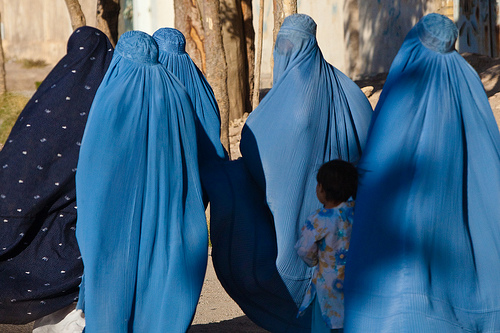
“If someone is sentenced to death, they must be killed with a gun, and photographing the execution is forbidden.” So goes one of the directives handed down by Taliban leader Mullah Omar in an effort to avoid images that might cause a rift between the movement and supporters. It was part of a 69-point document, published in May 2009, which formed a new PR strategy designed to recast the insurgency around local liberation rather than violent fundamentalism.
Western moves toward ‘reconciliation’ and withdrawal suggest that the strategy has helped to maintain the narrative of a war that ‘cannot be won’. Much of the recent media focus has been on abuses perpetrated by the coalition and its partners: the Wikileaks revelations, charges against British forces, and unlawful killings by the Pakistani military. These have contributed to the collapse in international public support – with 63 percent and 58 percent of UK and US populations now opposing the war.
Politically, the criteria for withdrawal has been narrowed. British Prime Minister Cameron said that he could “sum it up in two words…national security: clearing al-Qaida out of Afghanistan, damaging them in Pakistan. We don’t have some dreamy ideas about this mission.” President Obama now supports efforts to “open the door to the Taliban” and has backed Afghan President Karzai’s move to form a reconciliation ‘high peace council’ and invite the Taliban into parliament. As one western diplomat explained: “We are not going to be sending troops and spending money forever. There will have to be a compromise, and sacrifices will have to be made.”
But who, specifically, will be making the sacrifice? Last week, a UAE-owned television station provided an emphatic answer – if indeed it was ever doubted – by smuggling out what is believed to be the first verified recording of the Taliban stoning a woman. The grainy but horrifying images of a hooded victim kneeling before her executioners – after she was accused of “being seen with a man” – are testament to the reality of life for women in the Taliban-controlled areas of Afghanistan and Pakistan, under an ideological movement that also kills women who go to school, work or participate in the political process (along with the men who support them).
The reality of what is at stake is illustrated in the story of Robina Jalalai, one of Afghanistan’s first two female Olympic athletes, who now trains “in the stadium where the Taliban used to play football with women’s heads.”
Of course, major foreign and security policy is rarely determined by such ‘dreamy’ issues as women’s rights. But would these sacrifices yield the peace and security that is promised?
To separate the West’s definition of success from gender issues seems to miss the point. The negotiated settlement that left Pakistan’s Swat Valley to the Taliban in 2008 is the only precedent for what is currently proposed in Afghanistan. In that case, the images of women being whipped and schools being torched were the most provocative evidence of the Taliban breaking their pledges regarding women, and so horrified Pakistanis that the army relaunched operations within months.
To think that such consequences can be avoided simply by requiring reconciling Taliban to renounce violence and accept the new constitution seems faintly fantastical given the movement’s ideological opposition to the international community’s goals and values. Thus, President Karzai’s rhetorical argument – of whether to first save a girl’s life or enable her to go to school – is surely a false choice. Implementing social reforms, such as the constitutional mandate guaranteeing 25 percent of parliamentary seats to female candidates, are now a key means of building a sustainable government that can meet western security requirements – and can only be achieved through improved governance and security, not a speedy reconciliation.
It’s true that there are numerous examples proving that states don’t need to be equal to be stable (see Saudi Arabia). Yet the memories of the last international withdrawal from Afghanistan are all too pertinent – when the US left the country too early after the Soviet defeat in 1989 and it became a playground for warlords and its neighbors geopolitical struggles. The violent subjugation of women in the 1990s was the first sign of the rising power of a movement that would facilitate the events of 9/11.
For Afghan women then, the sacrifice will be great. Last week’s revelations that the peace talks are “mostly hype” further add to this burden. Reports suggest that reconciliation consists primarily of the Karzai government using Iranian money to buy the loyalty of Taliban commanders, and that progress has been exaggerated to enable the US to reduce its commitment in its December strategy review.
It seems we have now reached a perverse reality, where images of Taliban abuses are as much a PR problem for western politicians as for the perpetrators themselves.


One reply on “Sacrificing the Women of Afghanistan”
Have every father and brother give their daughters and sisters a pistol with ammunition, train them carefully how and when to use it, and watch the Taliban back off their brutalization of helpless, unarmed women.